Boeing Bid To Sell F-15EX Eagles To India Faces Stiff Competition

Sebastien RoblinContributor
Aerospace & Defense
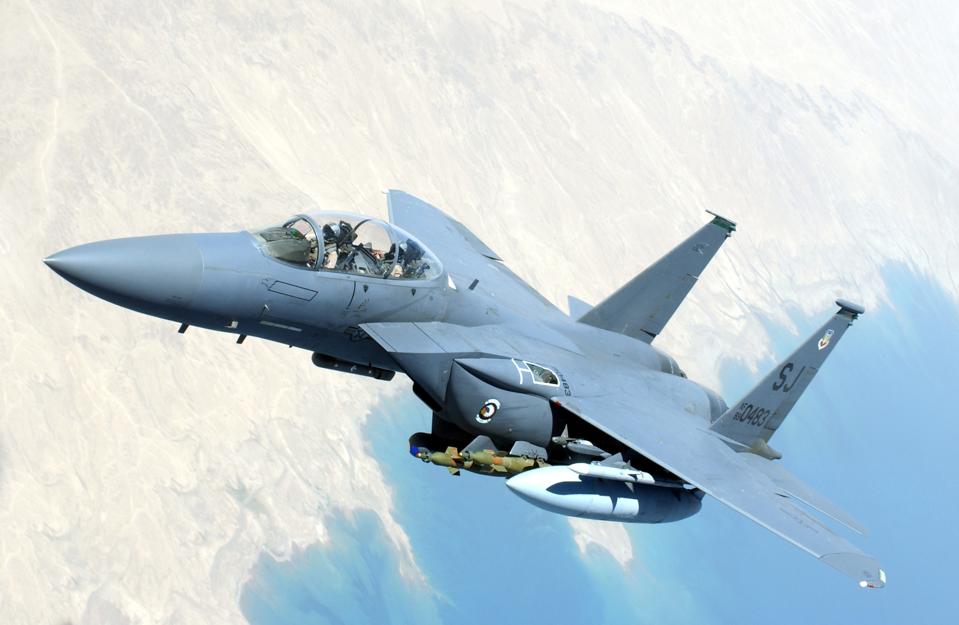
IN FLIGHT - JULY 6: In this handout image provided by the U.S. Air Force, an F-15 Strike Eagle ... [+]
GETTY IMAGES
Boeing BA -1.2% is showing growing interest in selling its F-15EX twin-engine multi-role fighters to the Indian Air Force. Back in February, Boeing Vice President Pratyush Kumar stated the company was seeking a license to export the F-15EX to India—a request which may soon be granted according to Indian defense journalist Shiv Aroor.
This latest variant of the nearly 50-year-old F-15 combines decades of upgrades developed for export model Eagles into a new multi-role platform for U.S. service with Air National Guard squadrons. The first eight F-15EXs out of an expected final order of 144 to 200 are due off the St. Louis assembly line in 2021.
Boeing has had some success exporting military aircraft to India, notably deals for Apache Guardian and Chinook helicopters, as well as C-17 transports and P-8I patrol planes. But it has so far been unsuccessful in offering another twin-engine fighter, the FA-18 Super Hornet, to meet the same Indian Air Force requirement the F-15 may be aimed at.
Recommended For Youhttps://www.forbes.com/sites/jimwan...-the-next-stimulus-package-expected-tomorrow/
If Boeing can secure the necessary authorizations, the venerable F-15—a type famously undefeated in air-to-air combat—may then confront a flock of more recent designs.
New Delhi’s Endless Quest for Foreign Fighters
India’s Medium Multi-Role Combat Aircraft (MMRCA) competition to procure between 126 to 200 “medium fighters” has been a mess since its inception in 2001, dragging on so long the Indian Air Force’s initial preferred choice, the Mirage 2000, ceased to be available for production.
In 2012, India decided to buy France’s cutting-edge Dassault Rafale fighter. But for the final deal signed in 2016, India only ordered 36 jets for €7.81 billion (over $9.2 billion). The resulting 41% increase in unit price caused a political scandal.
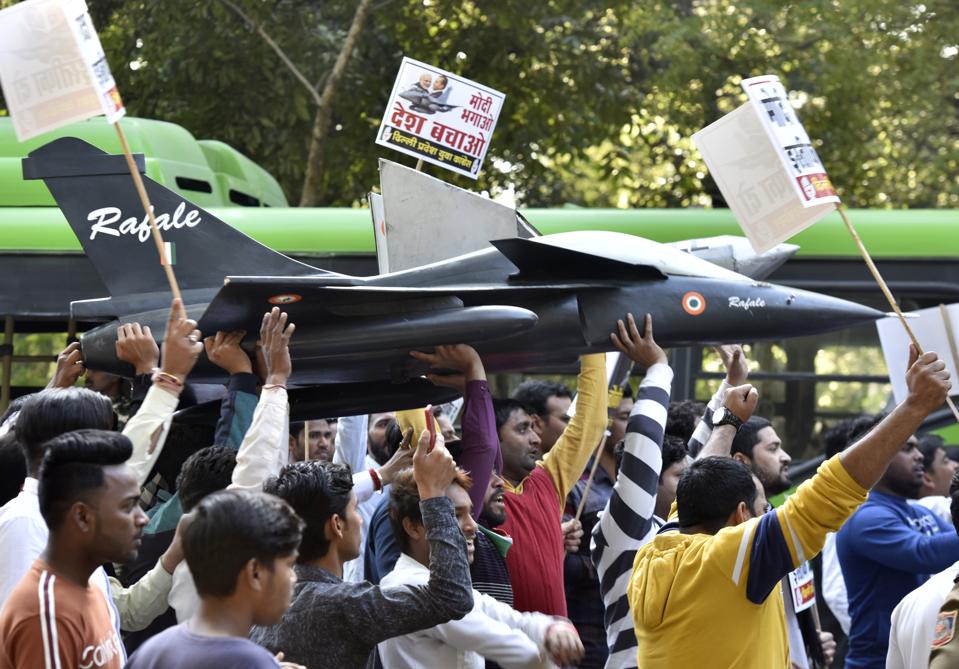
NEW DELHI, INDIA - MARCH 7: Activists of the Delhi Pradesh Youth Congress shout slogans during a ... [+]
HINDUSTAN TIMES VIA GETTY IMAGES
Facing a huge impending shortfall of fighters as India retires its old MiG-21 and MiG-27 jets, New Delhi then issued a new requirement for 114 single-engine light fighters, which seemingly boiled down to a choice between Swedish Saab’s JAS 39 Gripen fighter and an upgraded version of the Lockheed-Martin F-16 (later re-branded the F-21) built in India in cooperation with Tata.
This might have been a quick done deal, but the Indian Air Force apparently didn’t really want to consider only single-engine fighters and rebooted the procurement yet again in February 2018, this time allowing twin-engine aircraft. While the IAF has yet to issue specific requirements, it reportedly is now seeking 114 aircraft for a procurement that could total $15 billion or more.
For now, virtually every advanced fourth-generation jet fighter available for export (save for those from China, a military rival) is now on the table.
It’s worth noting India could also eventually end up pursuing a fifth-generation stealth aircraft: perhaps a a mature form of Russia’s Su-57 Felon stealth fighter—though New Delhi withdrew from a program to co-develop an Indian variant called the FGFA—or Lockheed’s fifth-generation F-35 stealth fighter, subject of some Indian interest.
What does the F-15 bring to the table?
The Indian Air Force faces a political choice as much as a technical one as New Delhi balances its relationship between its historical arms supplier Russia, and its growing partnership with Washington in countering pressure from China.
Notably, the U.S. CAATSA act means it could theoretically sanction India for Russian arms purchases, though it has so far refrained from doing so.
The choice will be hugely significant beyond the value of the airframes themselves. Combat aircraft are built for compatibility with national “eco-systems” of avionics (including radars, datalinks, electronic warfare suites etc.) and weapons ranging from air-to-air missiles to GPS-guided glide bombs.
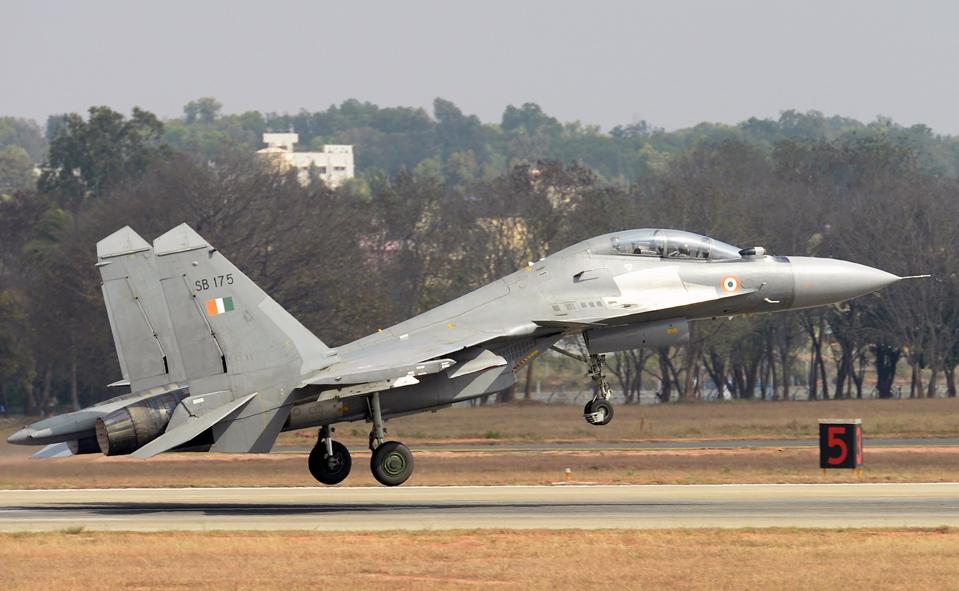
A Sukhoi Su-30MKI combat aircraft of the Indian Air Force takes off during an aerial display at ... [+]
AFP VIA GETTY IMAGES
For example, Russian R-73 and R-77 air-to-air missiles are compatible with both MiG-29 and Su-30 fighters; and a technician specialized in maintenance of one aircraft’s systems may more easily transfer those skills to work with another.
The IAF has never operated American jet fighters before. Currently the Indian Air Force flies Russian Su-30s, MiG-21s and MiG-29s and French Jaguars, Mirage 2000s and Rafales, in addition to its growing fleet of domestic Tejas jet fighters. The Indian Navy also operates MiG-29K carrier-based fighters. The IAF recently purchased 12 more Su-30s and 21 MiG-29s to shore up its flagging numbers.
A decision to purchase American-built fighters would require India to invest in a broader inventory of weapons and avionics systems, in turn encouraging further purchases from the United States. That would mark a politically significant break from its long history of Russian arm purchases.
The F-15EX versus the Field
Let’s consider the tradeoffs between various jet fighters being considered by the IAF.
On one end of the spectrum of choices are less expensive (but not unsophisticated), short-range single-engine tactical fighters, notably the Lockheed F-16/F-21, Saab Gripen and Russia’s Mikoyan-i-Gurevich MiG-35 (an evolved MiG-29).
Though these are excellent aircraft for sparring at the border, they may have difficulty carrying heavy loads over long distances, and one wonders if the IAF really is interested in single-engine fighters having rebooted the competition to include twin-engine jets. Furthermore, India just ordered 83 more domestic Tejas single-engine jets which fill that niche.
Next, there are middle-weight twin-engine jets like the Super Hornet, Rafale and the Eurofighter Typhoon to consider. Though not stealth aircraft, these later designs boast radar cross-sections around one-fifth or less that of the Eagle.
The Typhoon is superior at high-altitude, high-speed air-to-air combat, while the Rafale is stronger at lower altitudes, can operate from more austere airfields, and has better ability to penetrate air defense capabilities thanks to its SPECTRA electronic warfare self-defense system. Both have a slower maximum speed than the Eagle’s Mach 2.5, but are capable of cruising at supersonic speeds without using afterburners while the Eagle cannot.
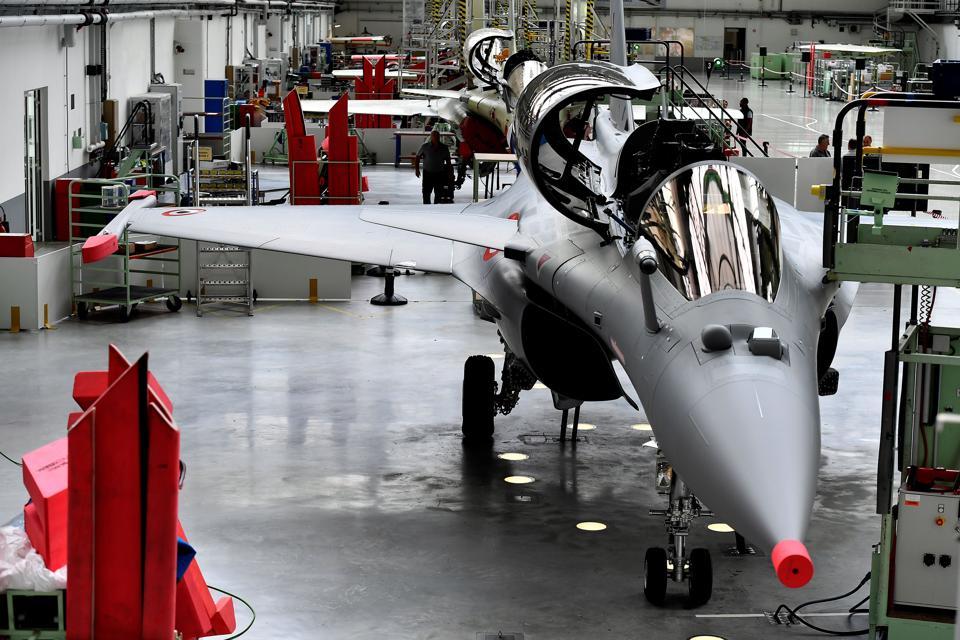
A French made Rafale jet fighter is exhibited in the workshops of Dassault-Aviation in Merignac near ... [+]
AFP VIA GETTY IMAGES
Boeing’s twin-engine FA-18E/F Super Hornet Block III is noted for its advanced networked sensors and it ability to achieve high angles of attack at low speeds. But though likely less expensive, it is limited by its short combat range and doesn’t exhibit the raw flight performance of its land-based European rivals.
It’s also worth recalling the IAF already chose the Rafale over the Typhoon, Super Hornet and F-16 in 2012. Reportedly the U.S. jets were downgraded because the IAF evaluation criteria emphasized hot-rod flight performance characteristics over avionics.
Further increasing the IAF’s small Rafale fleet may be more economical than procuring an entirely new type. However, the Super Hornet may also offer economies if it’s chosen to fulfill a requirement for 57 jets for the Indian Navy. The Super Hornet’s F414 turbofans may also be integrated in future Indian combat aircraft. (However, the Indian Navy is also considering the carrier-based Rafale-M!)
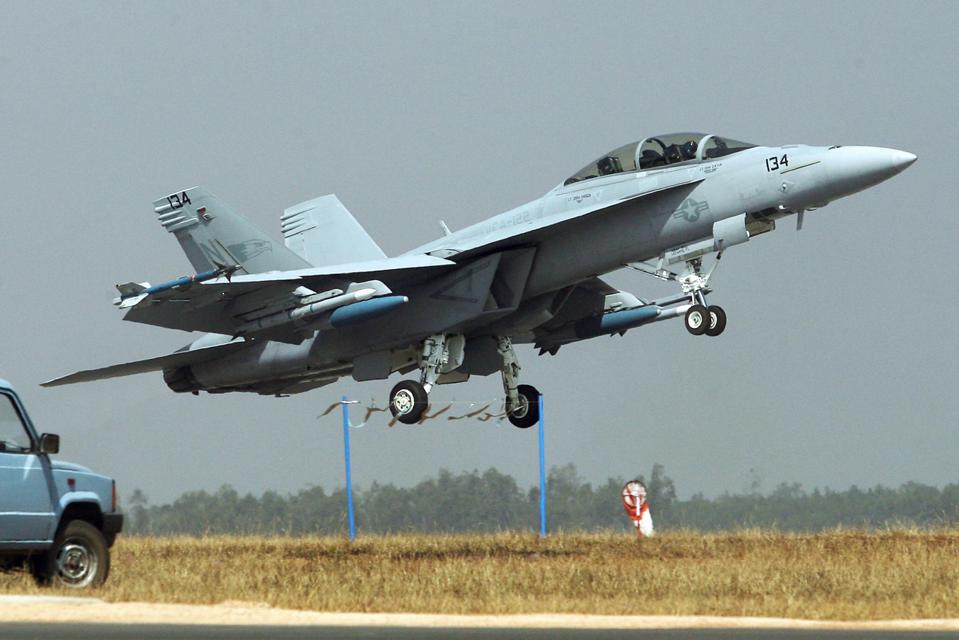
(FILES) This photograph taken on February 11, 2009, shows a US Navy F/A-18F Super Hornet strike ... [+]
AFP VIA GETTY IMAGES
Finally, on the heavy multi-role side of the spectrum are the F-15EX and its Russian counterpart, the Sukhoi Su-35S Flanker-E, a successor to the Su-30MKI Flanker-C jets in service with India.
Both the Eagle and Flanker-E are capable of attaining higher maximum speeds, flying longer distances, and carrying heavy payloads than the aforementioned light and medium fighters.
Why might India opt for a heavy fighter for its medium fighter competition? Long-range fighters may be desirable for patrolling the Indian Ocean where China’s PLA Navy is increasing its presence. Heavy fighters could also conduct penetrating strikes more deeply inside enemy territory—though admittedly at significant risk due to not being stealth aircraft. Finally, heavy fighters could carry heavier munitions, including potentially hypersonic missiles or India’s Brahmos cruise missile.
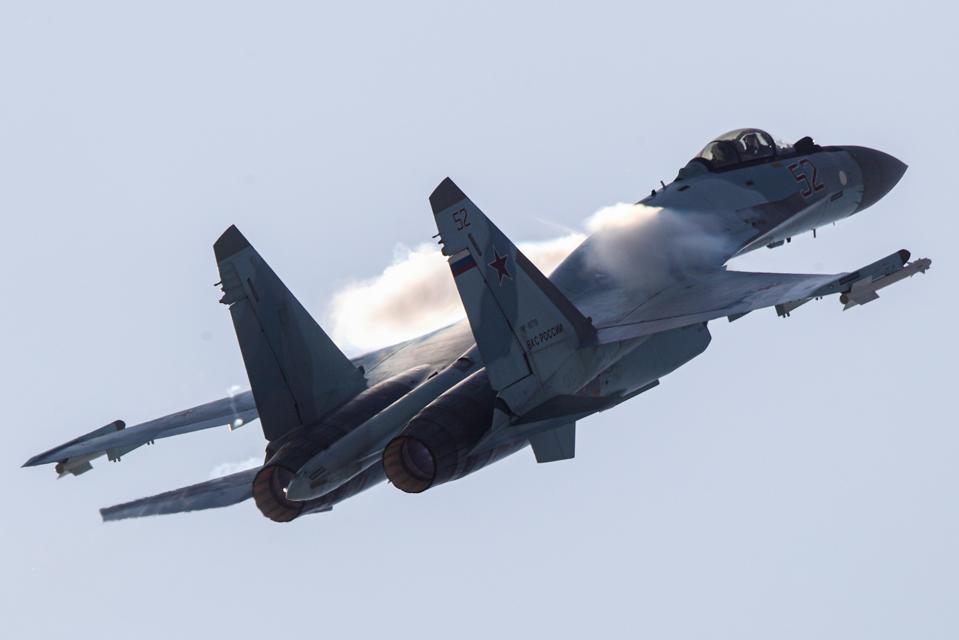
MOSCOW REGION, RUSSIA AUGUST 30, 2019: A Sukhoi Su-35S air superiority fighter performs a flight at ... [+]
SERGEI BOBYLEV/TASS
Compared head to head, the Su-35 undoubtedly is more maneuverable than the F-15EX thanks to its thrust-vector engines, boasts a powerful long-range multimode Irbis-E radar, and it’s airframe is moderately less visible on radar.
However, some of the F-15EX improvements narrow the gap between the earlier F-15C and the Su-35S in terms of sensors, self-defense systems, and payload.
For example, the F-15EX’s APG-82 AESA radar is arguably superior to the Su-35’s Irbis because it is higher-resolution, harder to detect and more resistant to jamming; it also can efficiently scan and jam simultaneously. The F-15EX also finally incorporates an infrared sensor, a longtime feature of Russian fighters. The F-15’s dated self-defense suite has also been updated with the new EPAWSS system.
In terms of munitions, Russian R-77 air-to-air missiles theoretically out-range U.S. AIM-120 missiles. However, India reportedly found in an air battle in 2019 that jets armed with R-77s were in practice outranged by Pakistani F-16s equipped with AIM-120Cs. Russia has also reportedly struggled to produce and deploy the more advanced R-77-1 variant.
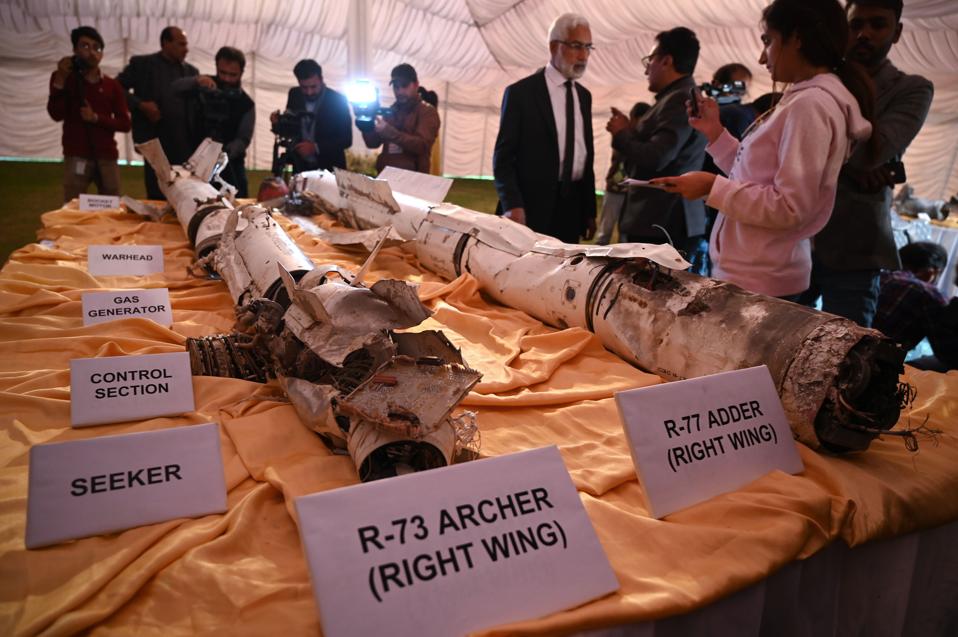
Media personnel take images of missiles of an Indian Mig-21 fighter aircraft, which was being flown ... [+]
AFP VIA GETTY IMAGES
Though Russia has produced diverse precision air-to-ground weapons, the U.S. has combat-tested and mass produced such weapons on a vastly greater scale.
In terms of price, the export Su-35 and F-15EX appear to come in the mid-$80 millions to $70 millions according to various reports. However, Russia has claimed it can build Su-35s for roughly half that price, so India might be able to bargain for a reduced rate.
Another important consideration: the Su-35S has a service life of 6,000 flight hours, while the F-15EX is rated for an extraordinary 20,000 hours. Furthermore, India has had reliability issues with its Russian-built MiG-29 and Su-30 aircraft.
In the end much remains uncertain regarding India’s fighter procurement. Is the IAF leaning towards light or heavy combat jets, or something in between? Will it opt to operates its first ever U.S.-built fighters, or keep things familiar by buying Russian as it usually has in the past? Or will New Delhi turn to a European manufacturer again?
Whatever the case, Boeing appears inclined to cast new chips into the pot of an already long-running game being played for very high stakes.
Follow me on Twitter.

Sebastien Roblin
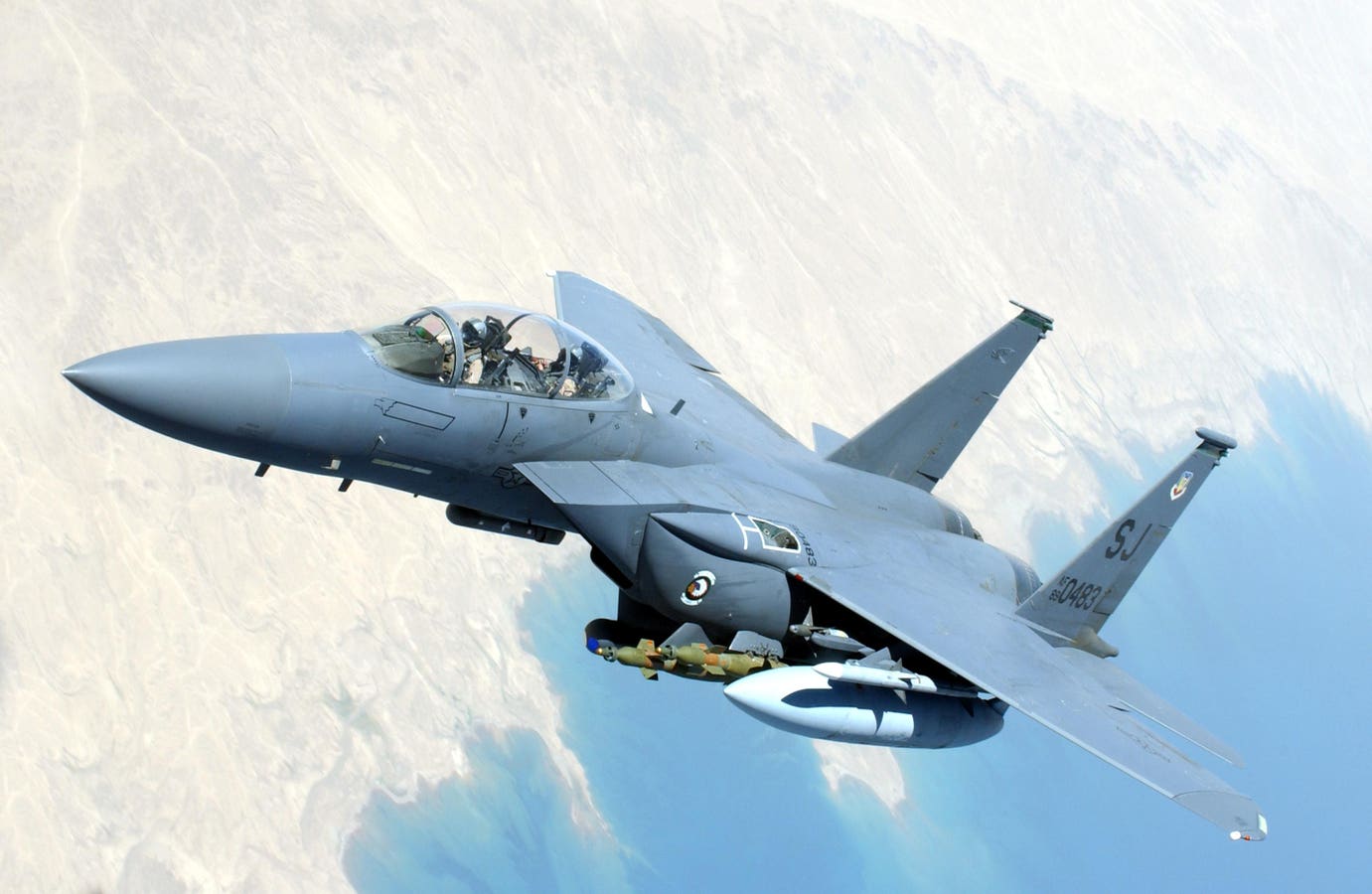
 www.forbes.com
www.forbes.com
Sebastien RoblinContributor
Aerospace & Defense

IN FLIGHT - JULY 6: In this handout image provided by the U.S. Air Force, an F-15 Strike Eagle ... [+]
GETTY IMAGES
Boeing BA -1.2% is showing growing interest in selling its F-15EX twin-engine multi-role fighters to the Indian Air Force. Back in February, Boeing Vice President Pratyush Kumar stated the company was seeking a license to export the F-15EX to India—a request which may soon be granted according to Indian defense journalist Shiv Aroor.
This latest variant of the nearly 50-year-old F-15 combines decades of upgrades developed for export model Eagles into a new multi-role platform for U.S. service with Air National Guard squadrons. The first eight F-15EXs out of an expected final order of 144 to 200 are due off the St. Louis assembly line in 2021.
Boeing has had some success exporting military aircraft to India, notably deals for Apache Guardian and Chinook helicopters, as well as C-17 transports and P-8I patrol planes. But it has so far been unsuccessful in offering another twin-engine fighter, the FA-18 Super Hornet, to meet the same Indian Air Force requirement the F-15 may be aimed at.
Recommended For Youhttps://www.forbes.com/sites/jimwan...-the-next-stimulus-package-expected-tomorrow/
If Boeing can secure the necessary authorizations, the venerable F-15—a type famously undefeated in air-to-air combat—may then confront a flock of more recent designs.
New Delhi’s Endless Quest for Foreign Fighters
India’s Medium Multi-Role Combat Aircraft (MMRCA) competition to procure between 126 to 200 “medium fighters” has been a mess since its inception in 2001, dragging on so long the Indian Air Force’s initial preferred choice, the Mirage 2000, ceased to be available for production.
In 2012, India decided to buy France’s cutting-edge Dassault Rafale fighter. But for the final deal signed in 2016, India only ordered 36 jets for €7.81 billion (over $9.2 billion). The resulting 41% increase in unit price caused a political scandal.

NEW DELHI, INDIA - MARCH 7: Activists of the Delhi Pradesh Youth Congress shout slogans during a ... [+]
HINDUSTAN TIMES VIA GETTY IMAGES
Facing a huge impending shortfall of fighters as India retires its old MiG-21 and MiG-27 jets, New Delhi then issued a new requirement for 114 single-engine light fighters, which seemingly boiled down to a choice between Swedish Saab’s JAS 39 Gripen fighter and an upgraded version of the Lockheed-Martin F-16 (later re-branded the F-21) built in India in cooperation with Tata.
This might have been a quick done deal, but the Indian Air Force apparently didn’t really want to consider only single-engine fighters and rebooted the procurement yet again in February 2018, this time allowing twin-engine aircraft. While the IAF has yet to issue specific requirements, it reportedly is now seeking 114 aircraft for a procurement that could total $15 billion or more.
For now, virtually every advanced fourth-generation jet fighter available for export (save for those from China, a military rival) is now on the table.
It’s worth noting India could also eventually end up pursuing a fifth-generation stealth aircraft: perhaps a a mature form of Russia’s Su-57 Felon stealth fighter—though New Delhi withdrew from a program to co-develop an Indian variant called the FGFA—or Lockheed’s fifth-generation F-35 stealth fighter, subject of some Indian interest.
What does the F-15 bring to the table?
The Indian Air Force faces a political choice as much as a technical one as New Delhi balances its relationship between its historical arms supplier Russia, and its growing partnership with Washington in countering pressure from China.
Notably, the U.S. CAATSA act means it could theoretically sanction India for Russian arms purchases, though it has so far refrained from doing so.
The choice will be hugely significant beyond the value of the airframes themselves. Combat aircraft are built for compatibility with national “eco-systems” of avionics (including radars, datalinks, electronic warfare suites etc.) and weapons ranging from air-to-air missiles to GPS-guided glide bombs.

A Sukhoi Su-30MKI combat aircraft of the Indian Air Force takes off during an aerial display at ... [+]
AFP VIA GETTY IMAGES
For example, Russian R-73 and R-77 air-to-air missiles are compatible with both MiG-29 and Su-30 fighters; and a technician specialized in maintenance of one aircraft’s systems may more easily transfer those skills to work with another.
The IAF has never operated American jet fighters before. Currently the Indian Air Force flies Russian Su-30s, MiG-21s and MiG-29s and French Jaguars, Mirage 2000s and Rafales, in addition to its growing fleet of domestic Tejas jet fighters. The Indian Navy also operates MiG-29K carrier-based fighters. The IAF recently purchased 12 more Su-30s and 21 MiG-29s to shore up its flagging numbers.
A decision to purchase American-built fighters would require India to invest in a broader inventory of weapons and avionics systems, in turn encouraging further purchases from the United States. That would mark a politically significant break from its long history of Russian arm purchases.
The F-15EX versus the Field
Let’s consider the tradeoffs between various jet fighters being considered by the IAF.
On one end of the spectrum of choices are less expensive (but not unsophisticated), short-range single-engine tactical fighters, notably the Lockheed F-16/F-21, Saab Gripen and Russia’s Mikoyan-i-Gurevich MiG-35 (an evolved MiG-29).
Though these are excellent aircraft for sparring at the border, they may have difficulty carrying heavy loads over long distances, and one wonders if the IAF really is interested in single-engine fighters having rebooted the competition to include twin-engine jets. Furthermore, India just ordered 83 more domestic Tejas single-engine jets which fill that niche.
Next, there are middle-weight twin-engine jets like the Super Hornet, Rafale and the Eurofighter Typhoon to consider. Though not stealth aircraft, these later designs boast radar cross-sections around one-fifth or less that of the Eagle.
The Typhoon is superior at high-altitude, high-speed air-to-air combat, while the Rafale is stronger at lower altitudes, can operate from more austere airfields, and has better ability to penetrate air defense capabilities thanks to its SPECTRA electronic warfare self-defense system. Both have a slower maximum speed than the Eagle’s Mach 2.5, but are capable of cruising at supersonic speeds without using afterburners while the Eagle cannot.

A French made Rafale jet fighter is exhibited in the workshops of Dassault-Aviation in Merignac near ... [+]
AFP VIA GETTY IMAGES
Boeing’s twin-engine FA-18E/F Super Hornet Block III is noted for its advanced networked sensors and it ability to achieve high angles of attack at low speeds. But though likely less expensive, it is limited by its short combat range and doesn’t exhibit the raw flight performance of its land-based European rivals.
It’s also worth recalling the IAF already chose the Rafale over the Typhoon, Super Hornet and F-16 in 2012. Reportedly the U.S. jets were downgraded because the IAF evaluation criteria emphasized hot-rod flight performance characteristics over avionics.
Further increasing the IAF’s small Rafale fleet may be more economical than procuring an entirely new type. However, the Super Hornet may also offer economies if it’s chosen to fulfill a requirement for 57 jets for the Indian Navy. The Super Hornet’s F414 turbofans may also be integrated in future Indian combat aircraft. (However, the Indian Navy is also considering the carrier-based Rafale-M!)

(FILES) This photograph taken on February 11, 2009, shows a US Navy F/A-18F Super Hornet strike ... [+]
AFP VIA GETTY IMAGES
Finally, on the heavy multi-role side of the spectrum are the F-15EX and its Russian counterpart, the Sukhoi Su-35S Flanker-E, a successor to the Su-30MKI Flanker-C jets in service with India.
Both the Eagle and Flanker-E are capable of attaining higher maximum speeds, flying longer distances, and carrying heavy payloads than the aforementioned light and medium fighters.
Why might India opt for a heavy fighter for its medium fighter competition? Long-range fighters may be desirable for patrolling the Indian Ocean where China’s PLA Navy is increasing its presence. Heavy fighters could also conduct penetrating strikes more deeply inside enemy territory—though admittedly at significant risk due to not being stealth aircraft. Finally, heavy fighters could carry heavier munitions, including potentially hypersonic missiles or India’s Brahmos cruise missile.

MOSCOW REGION, RUSSIA AUGUST 30, 2019: A Sukhoi Su-35S air superiority fighter performs a flight at ... [+]
SERGEI BOBYLEV/TASS
Compared head to head, the Su-35 undoubtedly is more maneuverable than the F-15EX thanks to its thrust-vector engines, boasts a powerful long-range multimode Irbis-E radar, and it’s airframe is moderately less visible on radar.
However, some of the F-15EX improvements narrow the gap between the earlier F-15C and the Su-35S in terms of sensors, self-defense systems, and payload.
For example, the F-15EX’s APG-82 AESA radar is arguably superior to the Su-35’s Irbis because it is higher-resolution, harder to detect and more resistant to jamming; it also can efficiently scan and jam simultaneously. The F-15EX also finally incorporates an infrared sensor, a longtime feature of Russian fighters. The F-15’s dated self-defense suite has also been updated with the new EPAWSS system.
In terms of munitions, Russian R-77 air-to-air missiles theoretically out-range U.S. AIM-120 missiles. However, India reportedly found in an air battle in 2019 that jets armed with R-77s were in practice outranged by Pakistani F-16s equipped with AIM-120Cs. Russia has also reportedly struggled to produce and deploy the more advanced R-77-1 variant.

Media personnel take images of missiles of an Indian Mig-21 fighter aircraft, which was being flown ... [+]
AFP VIA GETTY IMAGES
Though Russia has produced diverse precision air-to-ground weapons, the U.S. has combat-tested and mass produced such weapons on a vastly greater scale.
In terms of price, the export Su-35 and F-15EX appear to come in the mid-$80 millions to $70 millions according to various reports. However, Russia has claimed it can build Su-35s for roughly half that price, so India might be able to bargain for a reduced rate.
Another important consideration: the Su-35S has a service life of 6,000 flight hours, while the F-15EX is rated for an extraordinary 20,000 hours. Furthermore, India has had reliability issues with its Russian-built MiG-29 and Su-30 aircraft.
In the end much remains uncertain regarding India’s fighter procurement. Is the IAF leaning towards light or heavy combat jets, or something in between? Will it opt to operates its first ever U.S.-built fighters, or keep things familiar by buying Russian as it usually has in the past? Or will New Delhi turn to a European manufacturer again?
Whatever the case, Boeing appears inclined to cast new chips into the pot of an already long-running game being played for very high stakes.
Follow me on Twitter.
Sebastien Roblin

Boeing Bid To Sell F-15EX Eagles To India Faces Stiff Competition
Boeing has had some success exporting military aircraft to India, but has so far failed to sell its twin-engine FA-18 Super Hornet jet fighter. If Boeing can secure the necessary authorizations, the venerable F-15—famously undefeated in air-to-air combat—may confront a flock of more recent designs.
 www.forbes.com
www.forbes.com





